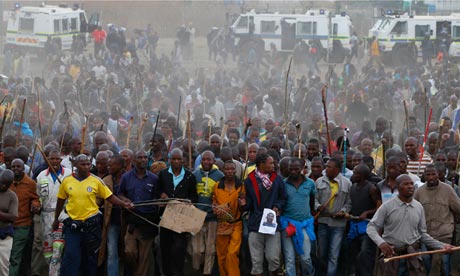South Africa: Dying for growth -- World Bank's role in Marikana massacre mine, carbon pollution

More than 3000 mineworkers take part in a march at Lonmin's Marikana mine in South Africa on September 5, 2012. Photograph by Mike Hutchings/REUTERS.
For more on the Marikana mine massacre, click HERE.
By Patrick Bond
September 5, 2012 -- Links International Journal of Socialist Renewal – “One of the things you learn as an anthropologist, you don’t come in and change the culture”, Dartmouth College president Jim Yong Kim told wealthy alumni when contemplating the institution’s notorious hazing practices, prior to US President Barack Obama’s request last February that he move to the World Bank.
Kim’s Harvard doctorate and medical degree, his founding of the heroic NGO Partners in Health and his directorship of the World Health Organization’s AIDS division make him the best-educated, most humane World Bank president yet. A decade ago, he co-edited the book, Dying for Growth, pointing out that "Washington Consensus" policies and projects had a sharply adverse impact on health.
No better examples here can be found than two "minerals-energy complex" investments approved by his predecessors Paul Wolfowitz in 2006 and Robert Zoellick in 2010. Kim should pay a visit because both are within an hour’s drive of the Johannesburg-Pretoria megalopolis, whose 10 million people live in the relatively barren area simply because of the gold’s discovery in 1886.
Though nearly all gone now, gold built the continent’s largest industrial complex, spewing vast pollution and undergirding apartheid. The old mines wrecked the water system with acid mine drainage, not to mention lives of hundreds of thousands of former workers now filing silicosis lawsuits against the mining houses, or similar numbers of HIV+ migrant workers and their wives back home in the old bantustans or neighbouring countries.
World Banks funds Lonmin, coal
Mining is again wrecking workers' health and creating socio-ecological chaos west of Johannesburg, at the Marikana platinum mine, where the World Bank’s International Finance Corporation invested US$15 million in Lonmin to enhance "community development". Wolfowitz authorised a further $135 million in equity and debt, but the price of platinum crashed by two-thirds in 2008, which made a further stake doubtful.
Far greater banking profits were generated in the World Bank’s biggest-ever project credit: the $3.75 billion Zoellick lent in April 2010, mainly for the construction of the third-largest coal-fired power plant on Earth, at Medupi.
The social and environmental balance sheet immediately went into the red, not only because the loan was granted just 20 months prior to Durban hosting the United Nations COP17 climate summit, when last December Zoellick unsuccessfully requested that the World Bank be given control of the potentially vast Green Climate Fund, with promised annual spending by 2020 of $100 billion.
Worse, the borrowing agent for Medupi was Eskom, which controversially bought billions of dollars worth of turbine boilers from Hitachi, in whose local subsidiary the African National Congress (ANC) held a quarter "black economic empowerment" share. In an obvious conflict of interest, Eskom’s chair, Valli Moosa, also sat on the ANC Finance Committee, drawing a rebuke of "improper conduct" from the Public Protector.
A substantial civil society coalition opposed Medupi, and the World Bank’s own inspection panel slated the loan. Yet when announcing Kim’s visit last week, the World Bank claimed that it “helps bring badly needed electricity to homes”.
In reality, the 130 per cent Eskom price increase from 2008-12 to pay for Medupi was borne not by the largest electricity consumer, BHP Billiton (which still gets the world’s cheapest power thanks to a 40-year apartheid-era deal), but by ordinary poor people. Power disconnections are now a leading cause of the surge in community protests, already at among the highest levels in the world.
The World Bank’s accompanying renewable energy credit to Medupi was a "fig leaf", confessed Tufts University Professor William Moomaw, a consultant to the Medupi loan.
And although according to the same bank announcement, “The World Bank Group’s program in South Africa is still in early stages”, the relationship began in 1951, with huge loans to Eskom to supply white households while blacks got no electricity until the 1980s, thanks to prevailing apartheid restrictions.
Kim is an optimist, pronouncing “Africa is truly taking off” on the eve of his departure this week. But his own institution’s 2011 book, The Changing Wealth of Nations, measured capital not just in financial terms but also with respect to the minerals beneath the soil, to capture the genuine "wealth of nations" in Africa.
Resource curse
In the process, the continent’s "adjusted net savings" was calculated at negative 7 per cent per year mainly due to non-renewable resource extraction: “Africa is consuming more than its current net income. It can only do this by liquidating its [natural] capital, which will leave its citizens poorer and with less capacity to generate income in the years to come.”
Herein Kim’s critical problem: extractive industries promoted by the World Bank are creating resource curses in Marikana, Medupi and everywhere. The day after the Marikana massacre, the Washington-based Center for International Environmental Law called on Kim to revisit his stake in Lonmin and reconsider the extractives sector.
If after this week’s trip, Kim decides to leave the toxic culture of South Africa’s minerals-energy complex unchanged, it will be yet another case of "dying for growth": profits for multinational capital at the expense of people and planet.
[Patrick Bond teaches development studies at the University of KwaZulu-Natal in Durban, where he directs the Centre for Civil Society.]